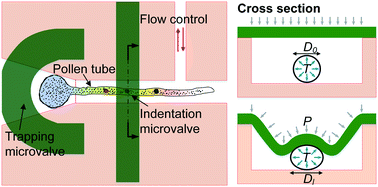Characterization of size-dependent mechanical properties of tip-growing cells using a lab-on-chip device†
Abstract
Quantification of mechanical properties of tissues, living cells, and cellular components is crucial for the modeling of plant developmental processes such as mechanotransduction. Pollen tubes are tip-growing cells that provide an ideal system to study the mechanical properties at the single cell level. In this article, a lab-on-a-chip (LOC) device is developed to quantitatively measure the biomechanical properties of lily (Lilium longiflorum) pollen tubes. A single pollen tube is fixed inside the microfluidic chip at a specific orientation and subjected to compression by a soft membrane. By comparing the deformation of the pollen tube at a given external load (compressibility) and the effect of turgor pressure on the tube diameter (stretch ratio) with finite element modeling, its mechanical properties are determined. The turgor pressure and wall stiffness of the pollen tubes are found to decrease considerably with increasing initial diameter of the pollen tubes. This observation supports the hypothesis that tip-growth is regulated by a delicate balance between turgor pressure and wall stiffness. The LOC device is modular and adaptable to a variety of cells that exhibit tip-growth, allowing for the straightforward measurement of mechanical properties.



 Please wait while we load your content...
Please wait while we load your content...